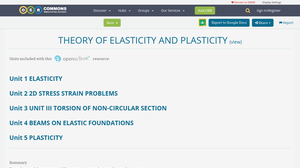
- Index notation equilibrium 3d elastic structure how to#
- Index notation equilibrium 3d elastic structure series#
Index notation equilibrium 3d elastic structure how to#
The full form of this equation is given, when this shows how to utilize HoldForm for equations in functional form. This is the same expression in functional form.

You can indicate the derivatives in functional form using the total derivative function Dt. You can still manipulatethe terms in this expression, however. In order to avoid multiplication of the indicial terms, such as the index of the term above, use HoldForm to wrap the subscriptions. You obtain the first of the strain-displacement relations by setting the option Notation to Indicial, that is, Notation ->Indicial. You can express the equations in indicial notation. You can also obtain the x-derivatives of the displacement terms in indicial notation. For example, the derivative of the x component of the displacement vector with respect to the x coordinate is depicted in the right-hand side term of the following relation. You denote a derivative with respect to a coordinate by a comma and the coordinate. Similarly, you can obtain the displacement components in cylindrical coordinates. In:=DisplacementComponents, Notation->Indicial] For instance, you display the displacements in Cartesian coordinates using the option Notation set to Indicial. In indicial notation, you use subscripts to denote the dependencies and the derivatives with respect to the coordinates. Options for the functions: DisplacementComponents, StrainComponents, StressComponents, ForceComponents, PotentialComponents, StrainDisplacementRelations, IsotropicStressStrainRelations, EquilibriumEquations, and ElastodynamicsEquations.

This is the functional form of displacement components in Cartesian coordinates. All expressions in the package are available in two formats: functional and indicial. The package GoverningEquations covers the three most widely used coordinate systems: Cartesian, cylindrical, and spherical. ħ.2.1 Coordinate Systems and Displacement Components The derivative of this term with respect to x in indicial notation is. For example, in functional form, u denotes the x component of the displacement vector in Cartesian coordinates. In functional format, the coordinate dependency and their derivatives with respect to coordinates of the physical quantities, such as strain, stress, and potential, are given in Mathematica function form. You can generate the equations in two types of formats: functional and indicial. The chapter introduces functions to deal with elasticity coefficients, strain-displacement relations, constitutive relations, and equilibrium and elastodynamics equations. The focus of this chapter is on the governing equations of the linearized theory of elasticity in three types of coordinate systems, namely, Cartesian, cylindrical, and spherical coordinates. In addition, because the equations of the theory of elasticity tend to become complicated, long, and consequently prone to error in manipulations, performing analyses in Mathematica increases efficiency and correctness.
Index notation equilibrium 3d elastic structure series#
Using pattern matching, series expansion functionality, and various manipulation facilities, you can implement very effective approximation techniques in the Mathematica environment. Mathematica has a large number of facilities to manipulate mathematical expressions. Similarly, you manipulate elasticity equations to find approximate solutions to the equations whose exact solutions are extremely difficult to find, if at all possible. The resulting problem is usually much easier to handle. For example, in generating the governing equations of a two-dimensional stress analysis problem, you eliminate the dependency in one coordinate in the three-dimensional equations. Often in solving elasticity problems, you need to algebraically manipulate the governing equations of the theory of elasticity.


 0 kommentar(er)
0 kommentar(er)
